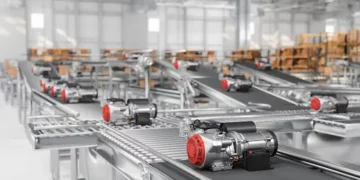In today’s rapidly evolving warehousing landscape, the adoption of motorized automated material handling equipment plays a pivotal role in enhancing both employee safety and operational efficiency.
The onset of the COVID-19 pandemic led to an unprecedented surge in online shopping, with a staggering 43% increase in 2020 alone. This surge has been predominantly managed through expansive, intricate warehousing and distribution hubs. In 2021, the UK witnessed a remarkable uptick in orders for new warehousing units, reaching levels not seen since 1985, with a total value of £5.6 billion.[1]
This surge in online shopping and the consequent demand for warehousing solutions coincided with a global labor shortage, making it increasingly challenging to swiftly fill staff vacancies. In such a scenario, automation systems have emerged as a viable solution. While robotic automation currently represents a modest fraction of warehouse investments, it is predicted to witness substantial growth, potentially surging from $3.6 billion in 2021 to $18 billion by 2025. As technology and AI continue to advance, automation systems are poised for even faster growth, leading to enhanced efficiencies and cost savings.
There are various ways through which automation can revolutionize the functioning of warehouses:
- Shuttle Systems: Warehouse shuttle systems are mobile transportation vehicles capable of moving between storage racks to retrieve and sort stock. These systems can efficiently utilize the warehouse’s floor space without the safety concerns associated with human-operated vehicles like forklifts.
- Sorting Machines: These systems are designed to divert, redirect, divide, and sort items such as parcels. They play a central role in improving accuracy, operational efficiency, and throughput in warehouse operations, allowing staff to focus on more complex tasks.
- AGV/AMR/AS/RS: Automated guided vehicles, autonomous mobile robots, automated storage, and automated retrieval systems can independently navigate through the warehouse, handling tasks like loading, distributing, and picking items without human intervention. They can operate across multiple floors, respond to obstacles in real-time, and adapt workflows to changing conditions.
- Palletizing Robots: Palletizing robot systems automate the placement and stacking of goods on pallets for transportation. These robots enhance efficiency by reducing cycle times, minimizing product breakage, and ensuring accurate packing processes.
- Strapping: Strapping technology includes solutions for packing and palletizing processes. These systems can be operator-assisted or fully automatic, helping save labor hours, minimize material usage, and reduce the warehouse’s carbon footprint.
- Bots: Motors are integral to various other bots, including bagging machines and cartonization equipment, facilitating tasks in the production line, picking, packing, and shipping processes.
- Conveyors: Automated conveyor systems are capable of handling repetitive tasks such as transportation, sorting, and loading more quickly and efficiently than human labor. They are particularly suited for high-volume distribution hubs.
Automation also extends to inventory robots, which continuously track stock movements, ensuring an up-to-date inventory. This helps maintain seamless supply chain operations, predicts demand, avoids delays, and ensures accurate and timely deliveries.
The primary advantage of automated robot systems in warehousing is their ability to perform repetitive tasks around the clock, resulting in cost savings on labor. Moreover, these systems reduce the risk of employee injuries, enhance accuracy, and ultimately prove cost-effective. However, the effectiveness of an automated system is closely tied to the reliability of its motor. Frequent breakdowns and downtime due to motor issues can hinder productivity.
Parvalux, a leading provider of standard and custom gear motor solutions, has been instrumental in supporting conveyor belt systems, picking systems, parcel sorting equipment, pallet shuttles, and automated storage and retrieval systems (ASRS) worldwide. Parvalux motors are known for their reliability, requiring minimal maintenance and ensuring minimal downtime.
To ensure efficient, dependable, and cost-effective drive systems, it is essential to select the most suitable motor for the equipment. Parvalux offers a wide range of AC, DC brushless, and brushed motors, which are highly regarded globally.
One notable addition to Parvalux’s motor lineup is the BLx60 brushless motor, designed with warehouse applications in mind. This motor offers several key features, including:
- High torque 4 Pole BLDC motor
- Continuous torques of up to 0.7Nm
- Voltage range of 12-48V DC
- NEMA 23 mountings
- IP54 protection
- Class F insulation
- Low noise and vibration resistance
The BLx60 is compatible with Parvalux encoders and brakes, Parvalux and maxon controllers, and gearheads. It also offers options for special windings and customizable shaft designs to meet specific requirements.
For further information on the BLx60 brushless motor and its potential contributions to your automated material handling equipment, visit the BLx60 range.
Get comprehensive supply chain report news updates at The Supply Chain Report. For international trade tools, see ADAMftd.com.
#MotorizedAutomatedMaterialHandling #WarehouseAutomation #EmployeeSafety #OperationalEfficiency #OnlineShoppingSurge #COVID19Impact #AutomatedWarehousing #ShuttleSystems #SortingMachines #AGV #AMR #ASRS #PalletizingRobots #StrappingTechnology #BotsInWarehousing #ConveyorSystems #InventoryRobots #LaborEfficiency #MotorReliability #ParvaluxMotors #BLx60BrushlessMotor #AutomatedMaterialHandlingEquipment #SupplyChainAutomation #WarehouseTech #DriveSystems #AutomationGrowth
















